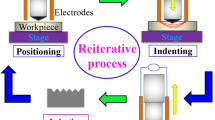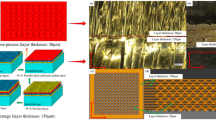Abstract
In an expected motion curve, signal attenuation or delay is often caused by the control model of a machine or its operating efficiency. Thus, the expected motion state often differs from the actual motion state. In addition, stamping products may have unexpected defects. In this study, the effect of motion curve errors on the forming properties of a direct-drive servo press was explored. First, a mechanical model of a direct-drive servo press was developed to rate theoretical motion curves. Subsequently, a laser measurement system was used to measure actual motion curves. The motion curve errors were optimized using integrated error criteria, and the most suitable integrated error criterion was identified to yield the smallest error. In addition, the optimized motion curve distribution was determined. Finally, the finite-element method was adopted to explore the V-bending manufacturing process and assess the changes in mechanical properties before and after motion curve optimization. The study results revealed that among the four adopted integrated error criteria with different stroke velocities, the integral square error criterion was the most suitable. This criterion can effectively reduce the differences between theoretical and actual motion curves. Accordingly, the aforementioned criterion was adopted for optimization, and the forming time was improved by 0.258–15.07%. According to V-bending simulations, the actual motion curves exhibited a strain rate attenuation of 8.74–20.98% at a stroke velocity of 5–20 strokes/min.















Similar content being viewed by others
Data availability
The datasets generated during and/or analyzed during the current study are available from the corresponding author on reasonable request.
References
Osakada K, Mori K, Altan T, Groche P (2011) Mechanical servo press technology for metal forming. CIRP Ann-Manuf Technol 60:651–672. https://doi.org/10.1016/j.cirp.2011.05.007
Xia Q, Xu T, Hong G, Ruan W (2014) Prediction of the sound pressure level of blanking noise during sheet-metal blanking using servo press with counterforce. J Mech Sci Technol 28:1673–1681. https://doi.org/10.1007/s12206-014-0312-2
Halicioglu R, Dulger LC, Bozdana AT (2017) Modeling, design, and implementation of a servo press for metal-forming application. Int J Adv Manuf Technol 91:2689–2700. https://doi.org/10.1007/s00170-016-9947-8
Matsumoto R, Jeon J, Utsunomiya H (2013) Shape accuracy in the forming of deep holes with retreat and advance pulse ram motion on a servo press. J Mater Process Technol 213:770–778. https://doi.org/10.1016/j.jmatprotec.2012.11.023
Song Q, Guo B, Li J (2013) Drawing motion profile planning and optimizing for heavy servo press. Int J Adv Manuf Technol 69:2819–2831. https://doi.org/10.1007/s00170-013-5246-9
Olguner S, Bozdana AT (2017) Influence of press ram pulsation on deep drawability of dual phase steel sheet. Acta Phys Pol A 132:742–745. https://doi.org/10.12693/APhysPolA.132.742
Kawamoto K, Ando H, Yamamichi K (2018) Application of servo presses to metal forming processes. Procedia Manuf 15:31–38. https://doi.org/10.1016/j.promfg.2018.07.166
Yildiz A, Kopmaz O (2015) Dynamic analysis of a mechanical press equipped with a half-toroidal continuously variable transmission. Int J Mater Prod Technol 50:22–36. https://doi.org/10.1504/IJMPT.2015.066864
Zhang Z, Wang L, Cao Y (2017) Phase-division-based dynamic optimization of linkages for drawing servo presses. Chin J Mech Eng 30:1426–1437. https://doi.org/10.1007/s10033-017-0195-0
Qu J (2018) Design and simulations of non-uniform velocity motion curves for a slider-crank servo press. Assem Autom 38:336–346. https://doi.org/10.1108/AA-10-2016-131
Maeno T, Mori K, Hori A (2014) Application of load pulsation using servo press to plate forging of stainless steel parts. J Mater Process Technol 214:1379–1387. https://doi.org/10.1016/j.jmatprotec.2014.01.018
Kütük ME, Dülger LC (2016) A hybrid press system: motion design and inverse kinematics issues. Eng Sci Technol 19:846–856. https://doi.org/10.1016/j.jestch.2015.11.012
Maeno T, Mori K, Ichikawa Y, Sugawara M (2017) Use of liquid lubricant for backward extrusion of cup with internal splines using pulsating motion. J Mater Process Technol 244:273–281. https://doi.org/10.1016/j.jmatprotec.2017.02.001
Halicioglu R, Dulger LC, Bozdana AT (2018) Improvement of metal forming quality by motion design. Robot Comput.-Integr Manuf 51:112–120. https://doi.org/10.1016/j.rcim.2017.11.010
He J, Gao F, Bai Y (2013) A two-step calibration methodology of multi-actuated mechanical servo press with parallel topology. Measurement 46:2269–2277. https://doi.org/10.1016/j.measurement.2013.03.031
Cheng PY, Chen PJ, Lin YT (2013) Small mechanical press with double-axis servo system for forming of small metal products. Int J Adv Manuf Technol 68:2371–2381. https://doi.org/10.1007/s00170-013-4851-y
Deng C, Xie SQ, Wu J, Shao XY (2014) Position error compensation of semi-closed loop servo system using support vector regression and fuzzy PID control. Int J Adv Manuf Technol 71:887–898. https://doi.org/10.1007/s00170-013-5495-7
Halicioglu R, Dulger LC, Bozdana AT (2017) An automation system for data processing and motion generation. 2017 International Artificial Intelligence and Data Processing Symposium (IDAP), Malatya 1–9. https://doi.org/10.1109/IDAP.2017.8090294
Liu C, Zhao S, Han X, Guo T (2017) High-accuracy servo press system for the clinching joint process. J Mech Sci Technol 31:903–910. https://doi.org/10.1007/s12206-017-0143-z
Zhang M, Lin X, Yin W (2013) An improved tuning method of fractional order proportional differentiation (FOPD) controller for the path tracking control of tractors. Biosyst Eng 116:478–486. https://doi.org/10.1016/j.biosystemseng.2013.10.001
Rahimian MA, Tavazoei MS (2014) Improving integral square error performance with implementable fractional-order PI controllers. Optim Control Appl Methods 35:303–323. https://doi.org/10.1002/oca.2069
Tabatabaei M (2016) PID controller design based on Laguerre orthonormal functions. Control Eng Appl Inform 18:65–76. http://www.ceai.srait.ro/index.php?journal=ceai&page=article&op=view&path%5B%5D=3672&path%5B%5D=1417
Jagatheesan K, Anand B, Dey KN, Ashour AS, Satapathy SC (2018) Performance evaluation of objective functions in automatic generation control of thermal power system using ant colony optimization technique-designed proportional–integral–derivative controller. Electr Eng 100:895–911. https://doi.org/10.1007/s00202-017-0555-x
Kuo CC, Huang HL, Li TC, Fang KL, Lin BT (2020) Optimization of the pulsating curve for servo stamping of rectangular cup. J Manuf Process A 56:990–1000. https://doi.org/10.1016/j.jmapro.2020.06.004
Polyblank JA, Allwood JM, Duncan SR (2014) Closed-loop control of product properties in metal forming: a review and prospectus. J Mater Process Technol 214:2333–2348. https://doi.org/10.1016/j.jmatprotec.2014.04.014
Allwood JM, Duncan SR, Cao J, Groche P, Hirt G, Kinsey B, Kuboki T, Liewald M, Sterzing A, Tekkaya AE (2016) Closed-loop control of product properties in metal forming. CIRP Ann Manuf Technol 65:573–596. https://doi.org/10.1016/j.cirp.2016.06.002
Djurdjanovic D, Mears L, Niaki FA, Haq AU, Li L (2017) Process and operations control in modern manufacturing, In International Manufacturing Science and Engineering Conference (Vol. 50749, p. V003T04A057). Am Soc Mech Eng. https://doi.org/10.1115/MSEC2017-3104
Wang N, Ilinich A, Chen M, Luckey G, D’Amours G (2019) A comparison study on forming limit prediction methods for hot stamping of 7075 aluminum sheet. Int J Mech Sci 151:444–460. https://doi.org/10.1016/j.ijmecsci.2018.12.002
Bueno M, Galdos L, de Argandoña ES, Weiss M, Rolfe B, Lou Y, Mendiguren J (2020) Strain rate effect on the fracture behavior of the AA5754 aluminum alloy. Procedia Manuf 47:1264–1269. https://doi.org/10.1016/j.promfg.2020.04.212
Cios G, Tokarski T, Żywczak A, Dziurka R, Stępień M, Gondek Ł, Marciszko M, Pawłowski B, Wieczerzak K, Bała P (2017) The investigation of strain-induced martensite reverse transformation in AISI 304 austenitic stainless steel. Metall and Mater Trans A 48:4999–5008. https://doi.org/10.1007/s11661-017-4228-1
Sunil S, Kapoor R (2020) Effect of strain rate on the formation of strain-induced martensite in AISI 304L stainless steel. Metall and Mater Trans A 51:5667–5676. https://doi.org/10.1007/s11661-020-05968-x
Acharya S, Moitra A, Bysakh S, Nanibabu M, Krishanan SA, Mukhopadhyay CK, Rajkumar KV, Sasikala G, Mukhopadhyay A, Mondal DK, Ghosh KS, Jha BB, Muraleedharana K (2019) Effect of high strain rate deformation on the properties of SS304L and SS316LN alloys. Mech Mater 136:103073. https://doi.org/10.1016/j.mechmat.2019.103073
Pan A, Zhang H, Liu J, Zhou W (2019) Parameter optimization of hot stamping for an extension part based on DYNAFORM under the background of new engineering. J Phys Conf Ser 1302:042031. https://doi.org/10.1088/1742-6596/1302/4/042031
Funding
This study was financially supported by Taiwan’s Ministry of Science and Technology (MOST 108–2221-E-992–064-MY3) and the Frontier Mould & Die Research and Development Center from The Featured Areas Research Center Program within the framework of the Higher Education Sprout Project of Taiwan’s Ministry of Education.
Author information
Authors and Affiliations
Contributions
The authors’ contributions are as described in the following text. All the authors conceived and designed the study. Cheng-Yu Yang, Chun-Chih Kuo, Kuo-Wang Liu, and Po-Hsien Li performed the theoretical deductions, experiments, finite-element simulations, process optimization, and analyses. Tse-Chang Li and Cheng-Yu Yang contributed to the interpretation of the results. Chun-Chih Kuo, Kuo-Wang Liu, and Po-Hsien Li were the main authors involved in writing the manuscript. Tse-Chang Li, Chun-Chih Kuo, and Bor-Tsuen Lin also contributed to manuscript writing. All the authors provided critical feedback and helped shape the research and analysis presented in this paper.
Corresponding author
Ethics declarations
Ethical approval
The authors claim that none of the contents in this manuscript has been published or considered for publication elsewhere. Besides, the research contents of the article do not violate ethics.
Consent to participate
This manuscript does not involve human or animal participation or data; therefore, consent to participate is not applicable.
Consent for publication
This manuscript does not contain data from any individual person; therefore, consent to publish is not applicable.
Competing interests
The authors declare no competing interests.
Additional information
Publisher's Note
Springer Nature remains neutral with regard to jurisdictional claims in published maps and institutional affiliations.
Rights and permissions
About this article
Cite this article
Li, TC., Kuo, CC., Yang, CY. et al. Influence of motion curve errors of direct-drive servo press on stamping properties. Int J Adv Manuf Technol 120, 4461–4476 (2022). https://doi.org/10.1007/s00170-022-09014-5
Received:
Accepted:
Published:
Issue Date:
DOI: https://doi.org/10.1007/s00170-022-09014-5




